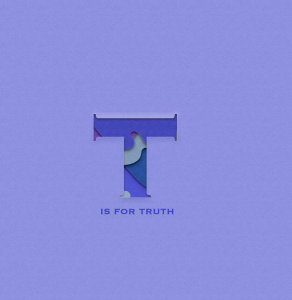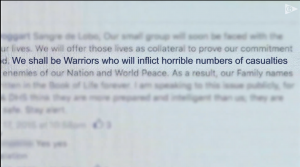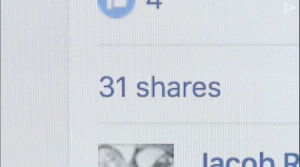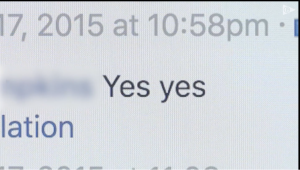life needs truth
“Life needs truth. Truth is essential.” With this forgotten life necessity, The New York Times closes its video, promising of truthful independent journalistic practice. I borrow this statement to start with, not to link it exclusively to the New York Times; it is as a comforting promise that might help grasp the following case with nobility and strength.
Nobility, from the privileged people to use journalism and the internet to speak the truth and facilitate for the already voice-full to voice out. Strength, for the less privileged to be self-reliant and empower themselves with all tools, including technology, to call for their rights and correct misrepresentations and false news.
Independent truth-committed journalism, makes life a bit more bearable, in the face of stereotyping, bias unjust media coverings, and rumours. Rumours that could lead to deadly terminal outcomings.
When I was navigating through Aeon magazine,which by the way is an intellectual and rich magazine worth checking out, I ended up at a page titled “When does US news ignore a terror plot? When the target is called Islamberg”, and this was the first time I hear about Islamberg and this terror plot.
Islamberg
Islamberg is a small settlement of few African Americans Muslim families located in upstate New York. Decades ago, these families decided to escape the fraught environment in Brooklyn city, counting the crack epidemic, at the time. The community’s vision was and still is to have a refuge, where they create a tranquil environment for themselves, to pray, harmonize with nature, and raise children.
But residents of Islamberg have found that there is no such thing as a safe haven in the internet age.
(Rojas Rick,2019)
Rumours haunted them. Far-right groups, anti-Muslim groups, and conspiracy theorists have created a fabricated portrayal of the community, spreading the rumour that they are hidden “terrorist sleeper cell” (Rojas Rick,2019). Misinformation -or- disinformation and misrepresentation spread through many mediums. The medium of the internet, Facebook pages, Twitter accounts, and Websites (e.g. Infowars), the medium of Tv news channels (e.g. Fox News), and documentary-style videos depicting Islamberg as terrorism camps where people are being schooled and trained.
One problem is that a large group of people believed and reacted with no questioning or fact-checking. A larger concern is that the reaction was not merely a personal discomfort, a couple of stares at every Muslim they encounter, or a protest for some form of law enforcement; the reaction was a planned attack on the village! A more systematic problem is that the media didn’t shed light on this planned terror plots. One study finds that “Terror attacks by Muslims receive 357% more press attention” (Chalabi Mona, 2018). For further details on this study and more, check this article.
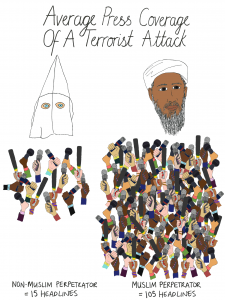
The White Fright
In 2015, the Islamberg community discovered that a Tennessee man, a former candidate for Congress, named Robert Doggart was scheming a deadly attack on the community. The White Fright is a 30 minutes documentary, produced by Emmy award-winning documentary filmmaker and national security journalist David Felix Sutcliffe, sheds light on this terror plot, Islamophobia, and the bias in national media coverings.
January 23th,2015
On this date, 63 years old Robert Doggart, posted a Facebook message looking for volunteers to participate in the attack on Islamberg. Robert Doggart, who collected 10,000 votes when running for Congress, used social media to strategically spread his extremist terrorist ideology. All of the information he spread was not true. Fox media and other facilitated spreading lies and made up imagined statements about the community. Although law enforcements ensured these groups repeatedly that such claims are not true, “Right-wing news outlets and boggers continue to identify Islamberg as national security threat” (White Fright,2018).
The following are some transcript of Robert’s recorded calls. Source: White Fright Documentary.
- “[ Robert]: We’re gonna be carrying an M4, 500 rounds of ammunition, light armor piercing, a pistol with three extra magazines, and a machete. And if it goes down to the machete, we will cut them to shreds. It has to be this way. It has to be done.”
- [ Robert]: Those guys have to be killed. Their buildings need to be burnt down and if we can get there and do that and get out without losin’ a man, even the better.”
- [ Robert]: Kill everybody.
- [ unrecognized name]: But there’s children up there.
- [ Robert]: I don’t want us to do that. But there’s always collateral damage.”
Here is one of Robert’s posts on Facebook with respective reactions. Figures 1 -3, Source: Screenshots from White Fright Documentary.
Hate speech on the internet
If we assume for the sake of argument that the internet is equally open to everyone, and that it promises for democracy and freedom of speech, what are the extents of freedom of speech? What is a rumour and what is the truth? What about extremist views? What will outweigh the other: further polarization or progressive harmonization? It is key not to romanticize the internet with this simplistic notion of its promises and possibilities. However, I believe it is necessary to deviate from the black and white outlook of the internet. Informed by relatively pessimistic views such as Morvoz’s and relatively positive views such as Shirky’s, we shall sketch a moving forward road map.
We are witnessing, simultaneously, amplified awareness and liberating discourses, and disastrous ignorance, stereotypes, and deadly rumours. With bias and racist agendas, some groups end up paying way higher price than others. Although terrorism knows no race nor religion, how much light is shed on “Islamist” terrorism and how much is shed on “white Christian and Jewish” terrorism? Media is not a source to solely rely on. Same goes for social media platforms; like, Facebook.
Facebook aims to prohibit content with “Controversial, Harmful and Hateful Speech”; to what extent is Facebook meeting its promises? How does Facebook frame its decision-making process upon deleting content? Is there a bias in taking action about misethnic content?And is there enough monitoring? That is why “Social media companies, led by Facebook, now face a reckoning over what critics call indefensible excuses for amplifying divisions, hate and misinformation on their platforms. Civil rights groups have called on large advertisers to stop Facebook ad campaigns during July, saying the social network isn’t doing enough to curtail racist and violent content on its platform.”
One study that applied qualitative content analysis over Facebook’s hate speech removal process reveals that “only about half of reported content containing hate speech was removed”. In specific, one subsection of the paper reveals how there was inconsistency with the removal process.
Hate speech is hate speech regardless of the ideology it is formed with, yet; is there bias when it comes to deleting/monitoring these speeches? If the following racism is witnessed in media coverages, does it indicate of possibily the same bias in social media platforms monitoring content? Since journalism, policy making, and online debates derive from each other.
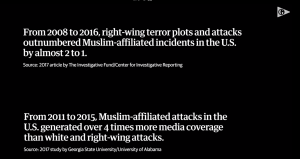
Discourse
Finally, through journalism and social media platforms, discourses are generated. “[T]he disparities in news coverage of attacks based on the perpetrator’s religion may explain why members of the public tend to fear the “Muslim terrorist” while ignoring other threats. More representative coverage could help to bring public perception in line with reality” (Kearns, E.M., Betus, A. & Lemieux, A, 2018).
If the world problems call for censorship over people; then it is a priority to have censorship on media and technology owner’s institutions. Nonetheless, responsibility on us, the people, is enlarged. We have to be mindful. We have to pause, question, reflect, double-check, and not be passive receivers, likers, sharers, re-tweeters.
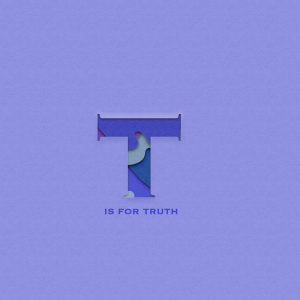
“Truth” can be constructed with certain bias, false, and misrepresentative discourse that gets repetitively associated with certain groups, leading to an enlarged sense of illusion that this group of people are harmful and that terrorism is exclusively associated with them. I am afraid that even if we investigate, educate, and are mindful; media repetitive messages get to the subconscious. A subconscious that might blur the truth and the convivial outlook of other citizens of the world.
Food For Thought💡
As a final food for thought, why is it when a Muslim does something wrong, it is referred to as “Islamic” terrorism; however when a man, video streaming himself as if in a video game, walks into a mosque in Christchurch, New Zealand, kills fifty one human beings; kids, women, and elderly with cold blood, media is reluctant to call it “White” terrorism, “Christian” terrorism, .. ? So why are labels being used for terrorism committed by one belonging to some ethnic groups, but not some others? This is not to say that labels should be used for everyone; it is to say the exact opposite; it is to say that labelling in the first place is a big skewed biased lie. Terrorism is terrorism regardless of who committed it…
https://aeon.co/videos/when-does-us-news-ignore-a-terror-plot-when-the-target-is-called-islamberg

